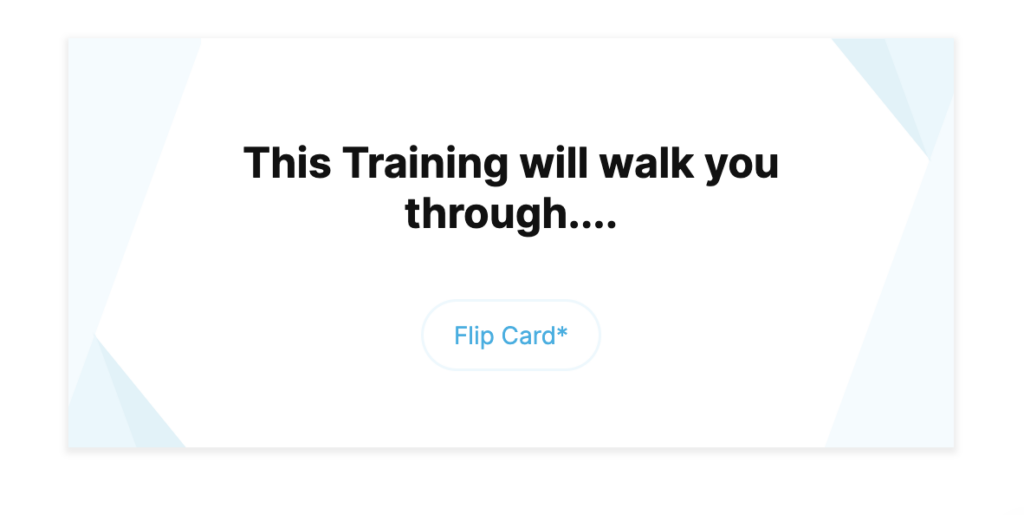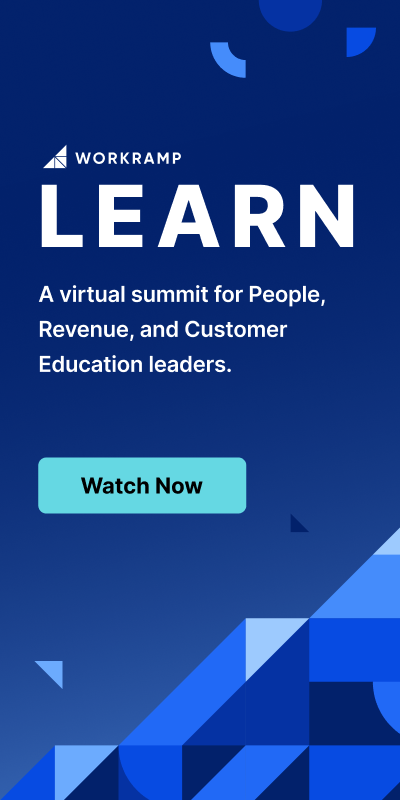What is Microlearning? Best Practices, Benefits, & Top Examples
Anna Spooner | WorkRamp Contributor
View bioLearning Tips Straight to Your Inbox
Microlearning can help learners overcome one of the biggest challenges in gaining new information: our tendency to forget quickly.
As far back as 1885, researchers have known that we forget new information at a startling rate. Studies show we forget around 50 percent of what we learn within a single hour, 70 percent by the end of the day, and 90 percent within a week.
However, when your learning and development program includes teaching important topics in bite-sized pieces and reinforcing new information over time, your teams will be far better able to remember their training and put it to use in their work.
In this post:
What is microlearning?
You may be wondering, what is microlearning? But, chances are you have already experienced microlearning without knowing it.
Often microlearning happens naturally. For example, when your parents told you to stand up straight or hold your fork a certain way at the table, they gave highly relevant microlessons.
Corporate learning and development (L&D) teams have recently adopted a similar approach. Recognizing that people are busier than ever, forget new information quickly, and need to apply what they’ve learned to retain it, L&D professionals have created bite-sized on-demand learning modules.
Microlearning is:
- Quick. Allowing learners to understand a new piece of information or process in just a few minutes
- Flexible. Fitting into an employees schedule when they are available, rather than requiring them to set aside work to learn
- Personalized. Allowing team members to choose what to learn based on their immediate needs and interests
- Easy to use. Because the learning can happen in a variety of settings and can be accessed on multiple types of devices
Why is microlearning important?
Is microlearning really that important? After all, haven’t companies successfully used traditional training formats for decades?
Whether companies have been successful with old-school training methods is up for debate, especially as current research reveals more about how quickly we forget what we learn. However, the reality is that people have access to far more information and technology than ever before, and today people have very short attention spans.
Learning styles have changed dramatically, which makes microlearning essential. By creating short, personalized, and relevant training modules, you can meet your team members exactly where they are and deliver the information they need.
Other benefits of microlearning include:
- Inexpensive and quick to develop. Because you’re creating shorter modules, you can have them done quickly with less money, which helps you react to the changing needs of your departments and teams.
- Easier to retain. When you learn something new in a short burst and immediately apply it, you’re much more likely to remember the new information. Having brief modules makes the material easier to review as well.
- Fits into spare time. A common refrain is that employees often have to “look busy” despite not having much to do. Microlearning allows your team to use that occasional downtime to do something engaging that helps them perform better and grow their careers.
- You can use various modalities. Microlearning can be developed as a game, a video, an infographic, and more. As a result, it’s more fun to develop and use.
L&D is essential for your organization to grow, adapt to the market and competition, and have talented employees ready to step into leadership roles. By creating L&D modules that fit into your team members’ schedules, you’ll be better able to help your company succeed.
Types and examples of microlearning
Microlearning can happen so quickly that you may not even recognize it as learning. Something as simple as a quick correction can provide a best practice you continue using for years.
Here are some well-known and lesser-known examples of microlearning.
Error message
An error message gives you a bite-sized piece of information you often need to act on immediately.
It doesn’t tell you everything about your device and the inner workings of the software. Instead, it simply gives you a short, often actionable, message about what’s wrong and how you can fix it.
Pop-ups
Pop-up explanations on websites are another example of microlearning. For instance, a website might have a small “i” you can hover over to get the definition of a specific term or process.
Sometimes if you hover over an icon, you’ll get a bubble that explains more about what will happen if you click it.

With the Learning Cloud from WorkRamp, you can use Flip Cards to offer additional information within learning content. This can help leaners retain important information.
Short videos
Microlearning videos are very popular online because they help you solve a specific problem, from finding a particular function in a software program to fixing a leaky faucet.
Microlearning videos don’t give you a complete foundation on software development or plumbing—they just focus on solving a single problem quickly.
Infographics
Infographics are a great example of microlearning. You get a lot of information put into a single engaging graphic.
Notice that no one lists facts—they use funny graphics and other visual elements to keep things exciting and improve understanding. Microlearning shouldn’t just be short; you also want content to be engaging.
Learning apps
Learning apps take advantage of microlearning because the developers know people are busy and on the go when using mobile devices.
Take a language-learning app; it might give you a single vocabulary word of the day or might have a five-minute lesson you complete daily. Either way, you’re learning something new in small, bite-sized pieces.
Microlearning benefits
Microlearning has a host of benefits for both the learners and L&D professionals.
Here are some benefits to remember as you plan to include microlearning in your training programs.
Quick to develop
Sometimes your L&D team needs to share updated information quickly, and you don’t have time to develop a full course. This is where microlearning can make a difference—you’re creating quick, targeted training, which takes less time.
When you use the Learning Cloud, you can take advantage of pre-built LMS content that allows you to deploy training modules even more quickly. Your team will save dozens of hours by starting with pre-built content and customizing it to meet your needs.
Lower initial investment
When you invest in continuous learning to keep employees engaged, many costs must be considered. The platform you use, like the Learning Cloud, should be multi-purpose so that you can use it for employee development, customer education, partner education, new hire training, sales enablement, and more. That will give you the best ROI.
You also want to consider the team hours invested in creating a training course. With microlearning, you can invest fewer team hours and get courses up more quickly. That means you’re investing less while still getting a significant impact on employee growth.
Information is easier to retain
When learners can get information in a short timeframe and apply it immediately, they retain it much better. Humans learn most effectively through short bursts of information, and micro-courses help you teach in a progressive fashion, where each short lesson builds on the last.
When your organization uses microlearning to create an opportunity for immediate application and other short courses that reinforce and build on the concept, your learners will retain the information far better than they do in traditional classes.
Flexible learning times
While the employees at your organization crave continuous learning, they are also very busy. How can the L&D team bring together this need for development and lack of time? Microlearning is the answer.
Because microlearning is not only short but can also be available on demand, learners have the opportunity to complete a 5- to 10-minute course whenever they have the availability. No one is locked into a class schedule that interrupts their workflow.
The flexibility of microlearning makes it much more convenient, so it’s far more likely that learners will complete the courses.
Offered through various modalities
Multimodal learning is when training courses use multiple learning methods to teach a concept. For example, microlearning can teach through video, reading text, an interactive exercise, and more.
Because each team member learns differently, it’s essential to cater to different learning styles in training materials. Microlearning makes that easy, especially if a learning management system like the Learning Cloud centralizes your training assets and files. With everything in one place, creating microlearning using various engaging training materials is easy.
Read more: Make eLearning Engaging in 7 Steps
Personalization options
Microlearning also allows for personalization depending on the learner’s needs. For example, one employee might need to go through a more comprehensive training process on a concept, while another only needs a refresher.
By creating microlearning courses that build upon a single concept, a learner can get a deep dive into the ideas, while another team member might need the first course as a reminder of key concepts.
Learners also have the opportunity to focus on the microlearning courses that are most relevant to them, getting bite-sized information on-demand that’s tailored to their goals and needs rather than having to take a longer one-size-fits-all class.
Read more: The Indispensable Power of Personalized L&D
Microlearning limitations
Microlearning is a powerful tool, but there may be better approaches for some situations. For example, teaching complexly interrelated topics can take time in a micro-course context. In addition, you have to do a lot of work to point out the relationships between concepts, which may not fit into a bite-sized module.
Also, microlearning covers one learning objective at a time. If you’re in an environment where you need to teach multiple concepts quickly, such as new hire training, it’s better to stick with other learning formats.
If you focus on microlearning to the exclusion of other teaching tools, you might also end up overspending. While creating a small course is often less expensive than a larger one, the costs will quickly increase if you create dozens of microlearning modules.
Finally, having dozens of microlearning options can be overwhelming. Research has shown that when given too many choices, people can become overwhelmed and feel unsatisfied no matter what they choose—a phenomenon known as the paradox of choice.
By carefully planning your L&D program and using microlearning in the right context, you can take advantage of the benefits and avoid the drawbacks.
Microlearning best practices to know
Knowing you have the right approach is essential, and learning from those who have done it can help you avoid common pitfalls and mistakes.
Here are some best practices you can adopt as you create your micro-courses.
Confirm it’s the right approach
As powerful as bite-sized learning is, it’s not perfect in every situation. Determine the purpose of the training program and see if microlearning fits.
For example, if you’re doing new-hire training, keeping everyone on the same page with an extended group learning experience is probably better. However, microlearning may be perfect if existing employees want to brush up on individual skills.
Know your learners
Different groups will have different needs to address in the training process. For example, a group of Gen Z sales reps will have different needs than a group of Gen X accounting employees.
Consider what types of learning content and cultural references make sense for both the audience and the topic. And remember, everyone loves engaging, interesting training modules, regardless of age or role.
Decide on content format
Should the module be an eLearning course, a video, or another format? Microlearning is short by nature, so it’s not a place you want to cram a half-dozen content types.
Instead, focus on just one or two and consider how it fits the audience and the topic.
For example, a micro-course could be a video followed by an interactive quiz. Or, you might create an infographic followed by an application activity. When you change things up, it stays exciting and fresh.
Use the right software
Choosing a learning platform that makes modules easy to access is crucial if you want microlearning to be effective.
For example, the Learning Cloud has several advantages for L&D teams. It makes it easy to access pre-built content and organize your learning assets in one place for use in multiple micro-courses, and it’s also a training management software that can be used for multiple organizational needs like employee training, customer and partner training, revenue enablement, and more.
Balance length and quality
A microlearning module must be long enough to communicate a key concept but short enough to keep the learner’s attention and fit easily into their schedule. The goal is to keep the module as short as possible without sacrificing the training quality.
At many organizations, the goal is to keep microlearning courses at five minutes or shorter. It can make sense to have training as long as 10 minutes, depending on the goal of the course. However, once you get past 10 minutes, you’re moving from microlearning into regular training courses.
Using a variety of media types, from text to graphics to video, can communicate a lot of information quickly while keeping the course fun and engaging.
Don’t start from scratch
One of the best parts of creating mini-courses is that you can repurpose existing materials. Take current training modules and find ways to make them bite-sized, engaging, and easy to access.
For example, if you already have a 20-minute training session on a particular topic, consider how to break it down into 4- to 5-minute micro-sessions. You may not need to create new content at all—you might just be able to repurpose existing materials.
L&D teams are always pressured to do more with their resources, and repurposing is a perfect way to meet that need.
Be accessible
Just because microlearning is short doesn’t mean you should skimp on high-quality design. Your training should be accessible to those with learning differences. For example, include captions for those who struggle with hearing and color pallet options for those who are color-blind.
It’s also vital for training to be available on demand so that team members can learn whenever they have availability, especially in today’s remote and hybrid work environments. When training is accessible, it’s much more likely to be completed.
Targeted and pragmatic
Excellent microlearning should be targeted to a specific need. Employees get the most out of training with a clear goal, whether you’re teaching a new process, answering a standard question, or providing a reminder to improve performance.
For example, you might create a microlearning course for the sales team to answer a single objection. Or, you could create microlearning for managers addressing how to prepare for an uncomfortable or difficult conversation with an employee.
These are focused and immediately applicable, which is a hallmark of high-quality microlearning.
Make it interesting
When something is short, the L&D team might assume they don’t need to put effort into making it interesting. You must create engaging content regardless of course length, including mixing in videos, humor, interaction, and more.
Of course, all elements must serve the primary purpose of teaching the concept in just a few minutes. As we mentioned, that might mean only using one or two different engagement methods—but you should still look for ways to make content engaging for users.
Make it interactive
Make eLearning interactive by adding elements like badges or roleplaying if you can.
Could microcourses award points that can be used for prizes? Be creative—interactivity makes a big difference in engagement and knowledge retention.
Create a culture of learning
Microlearning is best as part of a culture of learning where leaders can push information out to share new concepts or processes, and learners can pull information in when they have a specific question, interest, or need.
A learning culture allows people to grow both within their roles and into new positions within the organization, improving their skills along the way.
This growth is essential to keeping employees engaged and reducing turnover. According to the 2020 SHRM survey, employees with access to development opportunities are 15 percent more engaged and have a 34 percent higher retention rate. Microlearning makes skill development easily accessible to your teams.
What to know before you get started creating microlearning
Now that you know what microlearning is and its benefits, it’s time to lay the foundation for your course creation.
Before you dive into any new training module, it’s essential to answer these questions:
- Who are your learners? Different groups will have different needs to address in the training process. For example, a group of Gen Z sales reps will have different needs than a group of Gen X accounting employees.
- What type of content should you use? Should the module be an e-course, a video, a game, or another format? Which topics best suit micro-teaching, and which need other training approaches?
- What technology will you use? Choosing a learning platform that makes modules easy to access is important if you want microlearning to be effective.
Implement microlearning in your organization
Microlearning is a great way to help your teams improve their performance and advance in their careers. You can teach new skills, concepts, and processes in bite-sized, on-demand modules that are easy to use and allow for frequent reinforcement.
To implement microlearning in your organization, you need the right platform. The Learning Cloud can help you engage employees and create a learning culture using microlearning and traditional training approaches.
If you’d like to learn more about what the Learning Cloud can help you accomplish, contact us for a free, personalized demo.
Complete the form for a custom demo.
Recent Posts
- Why Secure LMS Platforms Are a Must for Regulated Industries July 10, 2025
- Top LMS Integrations That Power Smarter, Faster Learning July 2, 2025
- Introducing WorkRamp Analytics Studio: Unlocking Your Data Insights with AI June 30, 2025
- 11 AI LMS for AI-Powered Learning June 27, 2025
- The Best LMS Platforms for Customer Retention (2025 Guide) June 27, 2025
Anna Spooner
WorkRamp ContributorAnna Spooner is a digital strategist and marketer with over 11 years of experience. She writes content for various industries, including SaaS, medical and personal insurance, healthcare, education, marketing, and business. She enjoys the process of putting words around a company’s vision and is an expert at making complex ideas approachable and encouraging an audience to take action.
You might also like
3 reasons learning will propel your business forward
When you invest in talent, your team becomes unstoppable. Discover how learning is a growth engine to boost business impact and retain talent.
Read More
Try these strategies to improve employee engagement and performance
Companies with strong cultures see greater employee engagement and increased productivity. Learn to create a culture that promotes growth, helps you retain top talent, and drives results.
Read More
What is multimodal learning?
Creating a learning environment that considers your team's different needs isn’t easy. Here’s how to identify individual employee learning styles and create a development plan that engages your team.
Read More
Decrease Ramp Time and Increase Revenue
Get in touch to learn how WorkRamp can help you achieve your learning and development goals.
Request a Demo




